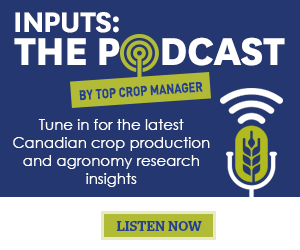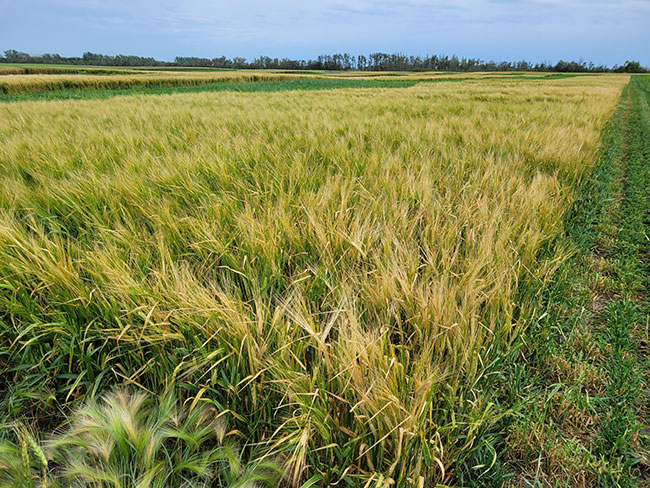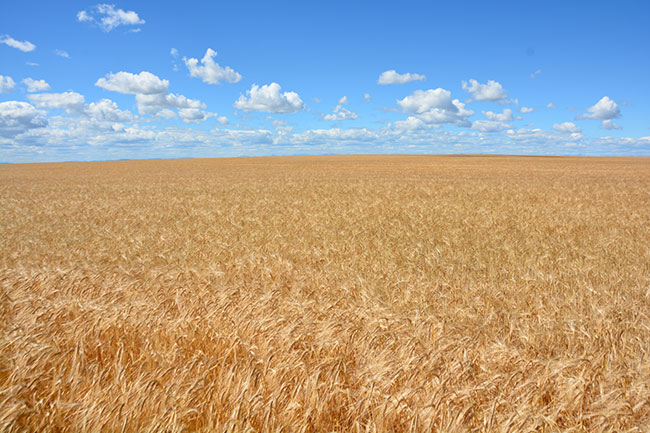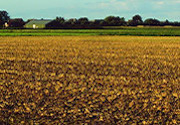| |
| |
 |
 |
| |
 |
|
@{mv_date_MMM d, yyyy}@ |
|
| |
Harvest progress sits at 13 per cent complete across the province, which is comparable with the five-year average harvest progress. Winter wheat and fall rye harvest is near completion, with 93 per cent of acres harvested.
» Read More...
During a visit to Saskatoon, Sask., federal Minister of Agriculture and Agri-Food Lawrence MacAulay delivered opening remarks for the 32nd meeting of the Tri-National Agricultural Accord and announced an investment of up to $4 million to the Western Grains Research Foundation (WGRF).
» Read More...
Olds College of Agriculture & Technology and Hebert Grain Ventures (HGV) announced the formation of an official Memorandum of Understanding (MOU), solidifying a collaboration on strategic initiatives aimed at driving innovation and growth in the agriculture industry in Alberta and Saskatchewan.
» Read More...
|
| |
 |
 |
| |
|
| |

In January, Sabine Banniza, a professor in the University of Saskatchewan’s College of Agriculture and Bioresources, received funding from Saskatchewan’s Agriculture Development Fund (ADF) and the Saskatchewan Pulse Growers Association for a four-year project to develop a multi-parent advanced generation intercross (MAGIC) lentil population that aims to have resistance to A. euteiches and F. avenaceum. In this episode of Inputs, Banniza speaks about the goals and intended methods of the MAGIC lentil project, lentil breeding and resistance genes in general and the challenges created by A. euteiches and F. avenaceum.
» Listen now |
| |
|
| |
 “New barley varieties offer higher yields, improved disease resistance and increased straw strength to prevent lodging compared to older varieties. Standard management practices for older varieties may not be suitable to maximize the opportunity for increased production with these varieties,” says Mike Hall, research coordinator with the East Central Research Foundation and Suncrest College (formerly Parkland College) at Yorkton, Sask.
» Learn more...
“New barley varieties offer higher yields, improved disease resistance and increased straw strength to prevent lodging compared to older varieties. Standard management practices for older varieties may not be suitable to maximize the opportunity for increased production with these varieties,” says Mike Hall, research coordinator with the East Central Research Foundation and Suncrest College (formerly Parkland College) at Yorkton, Sask.
» Learn more... |
| |
 The barley genome is roughly 5.3 giga bases and comprises five million nucleic acid-base pairs. That’s almost twice the size of the human genome. For this and other reasons, the recent assembly of the first Canadian barley reference genome represents a significant accomplishment, says Ana Badea, a research scientist in barley breeding and genetics for Agriculture and Agri-Food Canada (AAFC) based in Brandon, Man.
» Learn more...
The barley genome is roughly 5.3 giga bases and comprises five million nucleic acid-base pairs. That’s almost twice the size of the human genome. For this and other reasons, the recent assembly of the first Canadian barley reference genome represents a significant accomplishment, says Ana Badea, a research scientist in barley breeding and genetics for Agriculture and Agri-Food Canada (AAFC) based in Brandon, Man.
» Learn more... |
| |
| |
|
| |
 How do you slow the conversion of ammonium and minimize nitrogen leaching beyond the root zone? The answer is CENTURO®: a next-generation nitrogen stabilizer proven to give growers greater flexibility and protection while being gentle on anhydrous ammonia equipment. It’s crucial to protect spring-applied anhydrous. With the right plan in place, you can set yourself up for success. Keep reading to get other helpful tips about guarding your nitrogen investment.
» Read More...
How do you slow the conversion of ammonium and minimize nitrogen leaching beyond the root zone? The answer is CENTURO®: a next-generation nitrogen stabilizer proven to give growers greater flexibility and protection while being gentle on anhydrous ammonia equipment. It’s crucial to protect spring-applied anhydrous. With the right plan in place, you can set yourself up for success. Keep reading to get other helpful tips about guarding your nitrogen investment.
» Read More...
|
|
| |
|
| |
September 12, 2023 | 744906 Oxford Road #17, R.R. #6 Woodstock, Ontario
» Read More...
|
| |
| |








